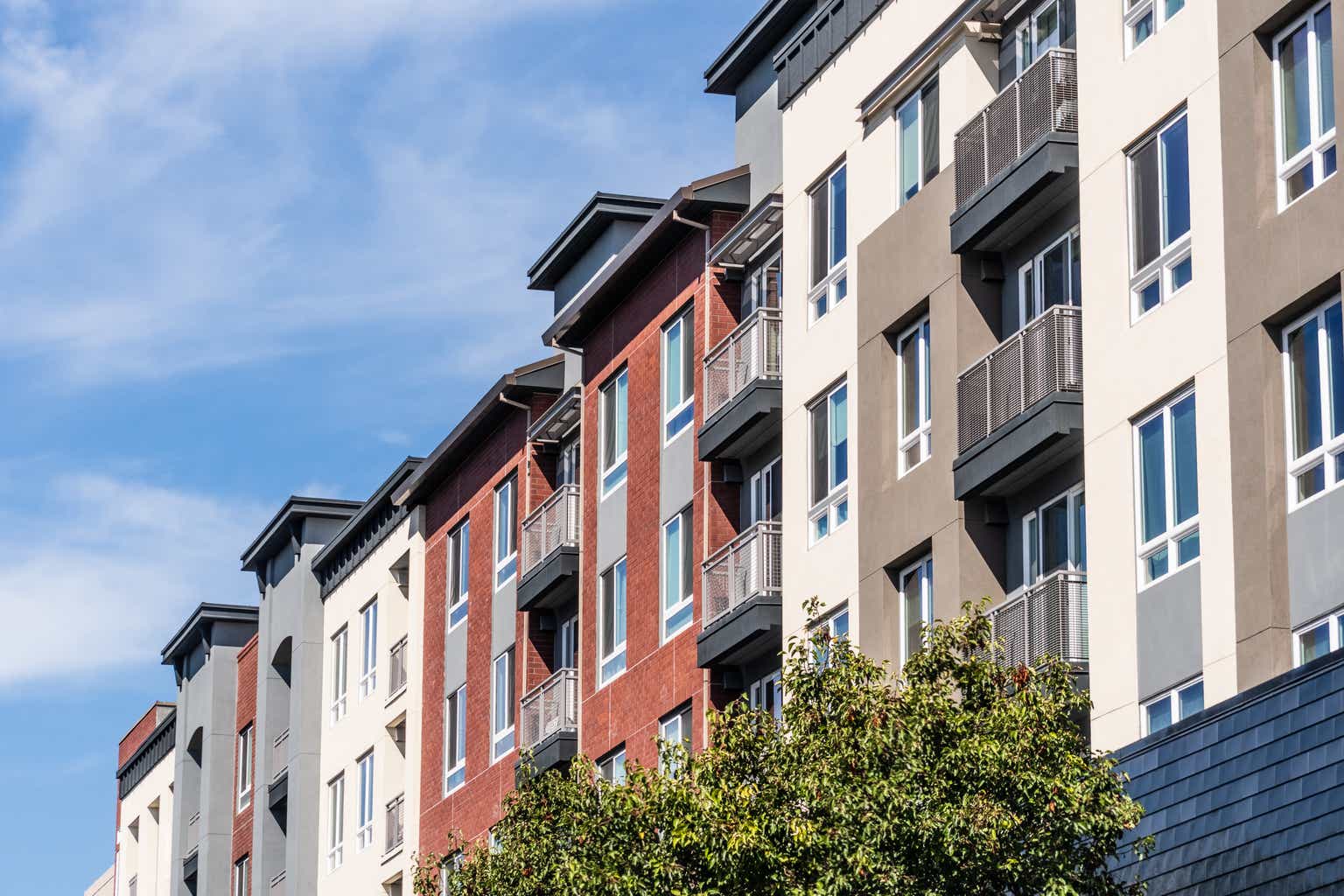Introduction
Grand City Properties (OTCPK:GRNNF), or GCP for short, recently suspended its 2023 dividend. As per the press release:
“The decision was taken as market uncertainties remain elevated and visibility on the full impact on leverage, transaction markets, valuation as well as on the cost of financing remain limited. GCP’s management believes that in the current market environment it is more prudent to be conservative in terms of capital and liquidity preservation while the Company continues to focus on deleveraging “
While disappointing for income investors, I think this is the right decision for the company long term. GCP remains attractively valued and has enough liquidity to cover maturities until 2026. As a result, I think income investors may want to see the dividend suspension as a buying opportunity to position in the shares for the long term. Furthermore, I reckon the shares offer solid price appreciation potential once interest rates are cut in the next 1-2 years.
Company Overview
You can access all GCP investor materials here. The company owns 63,000 apartments (excluding those held for sale), primarily in Germany (81% of the portfolio), and London (19%):
Portfolio Overview (Grand City Properties 2023 Annual Report)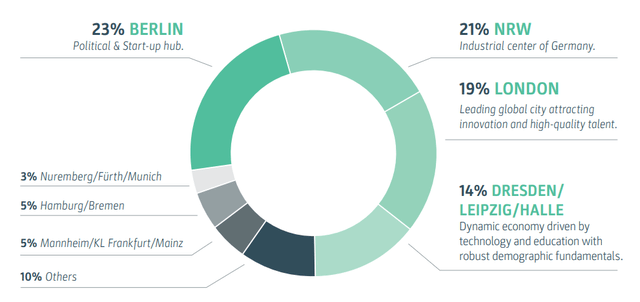
Operational Overview
The key performance indicator for GCP is Funds From Operations I (FFO I), defined as:
FFO I = Adjusted EBITDA – Finance expenses – Current tax expenses – minorities – interest on perpetual notes:
FFO I & FFO II Bridge (Grand City Properties Q4 2023 Results Presentation)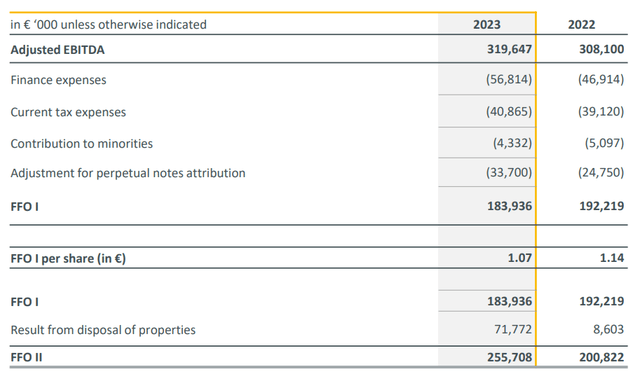
The company also reports FFO II, which takes into account disposal results. GCP aims for a long-term payout ratio of 75% of FFO I.
In 2023, GCP recorded an FFO I per share of €1.07/share, down 6% Y/Y, driven by higher interest expenses only partially compensated by higher EBITDA. The like-for-like rent growth was 3.3% in 2023 (2022: 2.9%), with occupancy improving to 96.2% at year-end (2022: 95.8%):
Key portfolio characteristics (Grand City Properties Q4 2023 Results Presentation)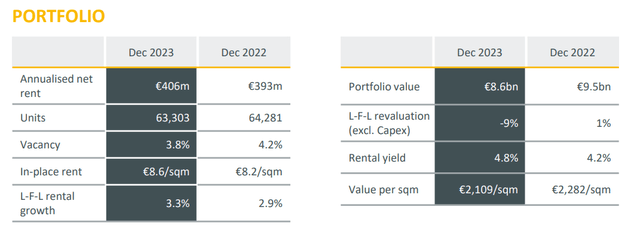
Debt Position
The company ended 2023 with a net debt of € 3.2 billion, a significant amount relative to its € 1.7 billion market capitalization. The average cost of debt was 1.9% at year-end (2022: 1.3%), with an average maturity of 5.3 years (2022: 5.9 years):
Leverage indicators (Grand City Properties Q4 2023 Results Presentation)
2024 Outlook
Looking ahead, GCP expects a 3% lower FFO I per share in 2024, at about € 1.04/share, driven by higher interest expenses, partially compensated by 3% like-for-like rent growth:
2024 Outlook (Grand City Properties Q4 2023 Results Presentation)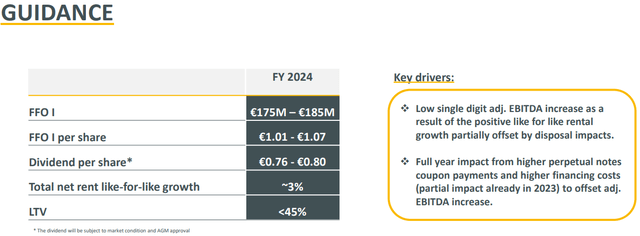
GCP may reinstate a dividend of about € 0.78/share in respect of 2024, dependent on market developments.
Property Valuation
At the end of 2023, GCP’s portfolio was valued at an EPRA net initial yield of 3.6%, up from the 3.2% at the end of 2022:
EPRA performance measures (Grand City Properties 2023 Annual Report)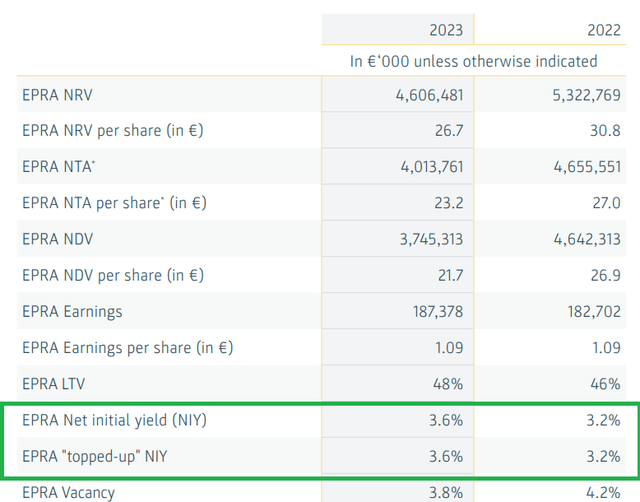
This resulted in an EPRA Net Tangible Assets, or EPRA NTA, of € 23.2/share. The more conservative EPRA Net Disposal value, or EPRA NDV, which accounts for deferred taxes (in GCP’s case about € 560 million) stood at € 21.7/share. The small difference between the two measures is partially due to a € 268 million benefit to EPRA NDV due to interest rates having risen in recent years (with GCP’s debt trading below par value as a result, hence worth less in a liquidation scenario which EPRA NDV somewhat assumes).
It should be noted that the € 560 million in taxes are only due if the property gains on the portfolio are realized, which I think is one reason GCP opted to skip its 2023 dividend – more retained earnings mean less disposals, and less disposals mean fewer realized gains and taxes paid as a result.
We can adjust the EPRA NDV for the effect of below-par debt. This results in an adjusted EPRA NDV of € 20.15/share.
Market-implied Cap Rate
Using the three net asset value metrics outlined above, and the EPRA loan-to-value measure of 48% (which is more conservative because it accounts for assets and debt on a proportionate basis, as opposed to the IFRS approach of full consolidation) we arrive at the below market-implied cap rates for GCP:
| EPRA NTA | EPRA NDV | Adjusted EPRA NDV | |
| NAV | 23.2 | 21.7 | 20.15 |
| Market-implied cap rate | 5.17% | 5.06% | 4.94% |
Source: Author calculations
We observe that the market-implied cap rate is around 4.9-5.2% depending on the exact NAV measure used.
Comparison with Vonovia
I will now compare GCP with Vonovia (OTCPK:VONOY), which I covered recently here. From a portfolio perspective, the main difference is GCP’s exposure to expensive London real estate, with Vonovia’s Austria/Sweden exposure generally in the low-tier segment of the market, in line with its German portfolio.
| MetricCompany | GCP | Vonovia |
| Occupancy | 96.2% | 98% |
| Like-for-like rent growth 2023 | 3.3% | 3.8% |
| Like-for-like rent growth 2024 (forecast) | 3% | 3.5% |
| EPRA net initial yield 2023 | 3.6% | 3.1% |
| Market net initial yield (EPRA NTA) | 5.17% | 4.01% |
| Market net initial yield (EPRA NDV) | 5.06% | 3.49% |
| Market net initial yield (Adjusted EPRA NDV) | 4.94% | 3.28% |
Source: Author calculations
We can observe that GCP’s portfolio shows higher vacancy, which clearly affects its market pricing position, with lower like-for-like rent growth in both 2023 and 2024. On the other hand, GCP’s portfolio is more conservatively valued (at a higher EPRA net initial yield) and does not suffer from the deferred tax problem at Vonovia to the same extent.
All in all, notwithstanding the risk related to expensive London real estate, GCP looks like a marginally better pick compared to Vonovia, largely due to its cheaper valuation which more than compensates for weaker rent growth.
Risks
Elevated debt levels remain the key risk for Grand City Properties, with an LTV ratio of 37-48% depending on the exact metric used. Using the market capitalization of the company, leverage stands at a stunning 65%. That said, the company has enough cash on hand (€ 1.2 billion) which together with signed but not yet closed disposals will allow GCP to meet all debt maturities until 2026. At that time, I expect the rate on the ECB’s deposit facility to be well below the current 4%, providing a more favorable refinancing environment.
Conclusion
Grand City Properties suspended its dividend for 2023 to preserve liquidity. Nevertheless, I think the company is attractively valued relative to its larger peer Vonovia, and potentially has higher long-term appreciation potential due to its smaller deferred tax burden. As a result, I think the shares are a buy both for turnaround income investors as well as those looking for long-term share price growth.
Thank you for reading.
Editor’s Note: This article discusses one or more securities that do not trade on a major U.S. exchange. Please be aware of the risks associated with these stocks.
Read the full article here





